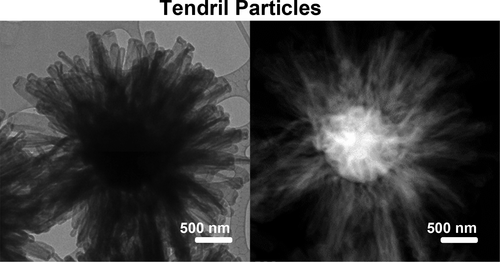当前位置:
X-MOL 学术
›
Chem. Mater.
›
论文详情
Our official English website, www.x-mol.net, welcomes your
feedback! (Note: you will need to create a separate account there.)
Omnidispersible Microscale Colloids with Nanoscale Polymeric Spikes
Chemistry of Materials ( IF 7.2 ) Pub Date : 2020-09-14 , DOI: 10.1021/acs.chemmater.0c02472 Douglas G. Montjoy , Harrison Hou , Joong Hwan Bahng 1 , Nicholas A. Kotov
Chemistry of Materials ( IF 7.2 ) Pub Date : 2020-09-14 , DOI: 10.1021/acs.chemmater.0c02472 Douglas G. Montjoy , Harrison Hou , Joong Hwan Bahng 1 , Nicholas A. Kotov
Affiliation

|
Particle stability in a multiplicity of fluid environments is critical for colloids used in catalysis, sensing, and composites. Hedgehog particles (HPs), inspired by the spiky topology of pollen grains and viral capsids, enable dispersion stability regardless of whether their polarity matches that of the solvent. Previous implementations of HPs were all based on rigid spikes from inorganic materials, such as ZnO, whereas polymeric spikes offer a unique spectrum of optical, chemical, thermal, and mechanical properties including potential stimuli-responsive behavior. Microscale particles with nanoscale polymeric spikes referred to here as tendril particles were made by layer-by-layer assembly of polyallylamine films deposited onto rigid ZnO templates and then cross-linked with glutaraldehyde. Tunable broadband scattering is observed upon partial removal of the ZnO with complete removal resulting in semirigid hollow polymer sleeves. While being hydrophilic, they disperse in nonpolar media such as heptane and high ionic strength aqueous media. Gradual removal of ZnO nanorods affords spectral tuning of the near-infrared band associated with light scattering from the high refractive index spikes. The polymer spikes also allow for loading of cargo nanoparticles, molecules, and polymers. By adding poly(N-isopropylacrylamide-co-acrylic acid) subunits, controlled aggregation is observed in response to temperature. Structural integration of dopamine moieties into the layered films allows for controlled aggregation in response to alkaline conditions. The mechanical and structural flexibility of tendrils with sleeve-like morphology enables a new generation of multifunctional particles with properties controlled by their nanoscale surface topology.
中文翻译:

具有纳米级聚合物钉的全分散微尺度胶体
在多种流体环境中,颗粒的稳定性对于催化,传感和复合材料中使用的胶体至关重要。受花粉粒和病毒衣壳的尖峰拓扑结构启发的刺猬颗粒(HPs),无论其极性是否与溶剂极性匹配,都能够实现分散稳定性。HP以前的实现都是基于无机材料(例如ZnO)的刚性尖峰,而聚合物尖峰提供了独特的光学,化学,热和机械特性谱,包括潜在的刺激响应行为。通过沉积在刚性ZnO模板上的聚烯丙胺薄膜的逐层组装,然后与戊二醛交联,制成具有纳米级聚合物尖峰的微米级颗粒(这里称为卷须颗粒)。在部分去除ZnO时观察到可调谐的宽带散射,而完全去除则导致半刚性空心聚合物套管。它们是亲水性的,它们分散在非极性介质中,例如庚烷和高离子强度的水性介质中。逐渐去除ZnO纳米棒可对与来自高折射率尖峰的光散射相关的近红外波段进行光谱调整。聚合物尖峰还允许装载货物纳米颗粒,分子和聚合物。通过添加poly(逐渐去除ZnO纳米棒可对与来自高折射率尖峰的光散射相关的近红外波段进行光谱调整。聚合物尖峰还允许装载货物纳米颗粒,分子和聚合物。通过添加poly(逐渐去除ZnO纳米棒可对与来自高折射率尖峰的光散射相关的近红外波段进行光谱调整。聚合物尖峰还允许装载货物纳米颗粒,分子和聚合物。通过添加poly(N-异丙基丙烯酰胺-共丙烯酸)亚单位,响应温度观察到受控的聚集。多巴胺部分到层状膜中的结构整合允许响应于碱性条件而受控的聚集。具有套筒状形态的卷须的机械和结构灵活性使新一代多功能颗粒的性能受到其纳米级表面拓扑结构的控制。
更新日期:2020-09-14
中文翻译:

具有纳米级聚合物钉的全分散微尺度胶体
在多种流体环境中,颗粒的稳定性对于催化,传感和复合材料中使用的胶体至关重要。受花粉粒和病毒衣壳的尖峰拓扑结构启发的刺猬颗粒(HPs),无论其极性是否与溶剂极性匹配,都能够实现分散稳定性。HP以前的实现都是基于无机材料(例如ZnO)的刚性尖峰,而聚合物尖峰提供了独特的光学,化学,热和机械特性谱,包括潜在的刺激响应行为。通过沉积在刚性ZnO模板上的聚烯丙胺薄膜的逐层组装,然后与戊二醛交联,制成具有纳米级聚合物尖峰的微米级颗粒(这里称为卷须颗粒)。在部分去除ZnO时观察到可调谐的宽带散射,而完全去除则导致半刚性空心聚合物套管。它们是亲水性的,它们分散在非极性介质中,例如庚烷和高离子强度的水性介质中。逐渐去除ZnO纳米棒可对与来自高折射率尖峰的光散射相关的近红外波段进行光谱调整。聚合物尖峰还允许装载货物纳米颗粒,分子和聚合物。通过添加poly(逐渐去除ZnO纳米棒可对与来自高折射率尖峰的光散射相关的近红外波段进行光谱调整。聚合物尖峰还允许装载货物纳米颗粒,分子和聚合物。通过添加poly(逐渐去除ZnO纳米棒可对与来自高折射率尖峰的光散射相关的近红外波段进行光谱调整。聚合物尖峰还允许装载货物纳米颗粒,分子和聚合物。通过添加poly(N-异丙基丙烯酰胺-共丙烯酸)亚单位,响应温度观察到受控的聚集。多巴胺部分到层状膜中的结构整合允许响应于碱性条件而受控的聚集。具有套筒状形态的卷须的机械和结构灵活性使新一代多功能颗粒的性能受到其纳米级表面拓扑结构的控制。











































 京公网安备 11010802027423号
京公网安备 11010802027423号